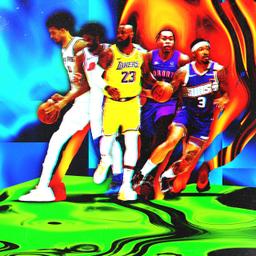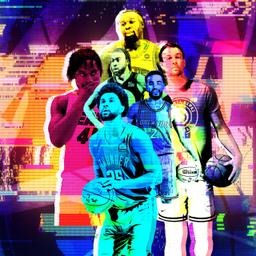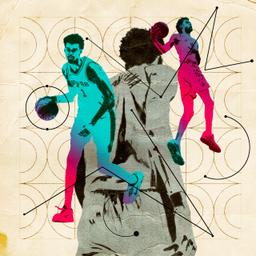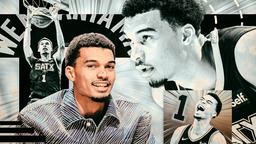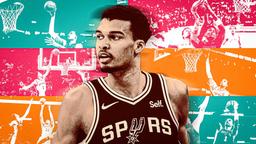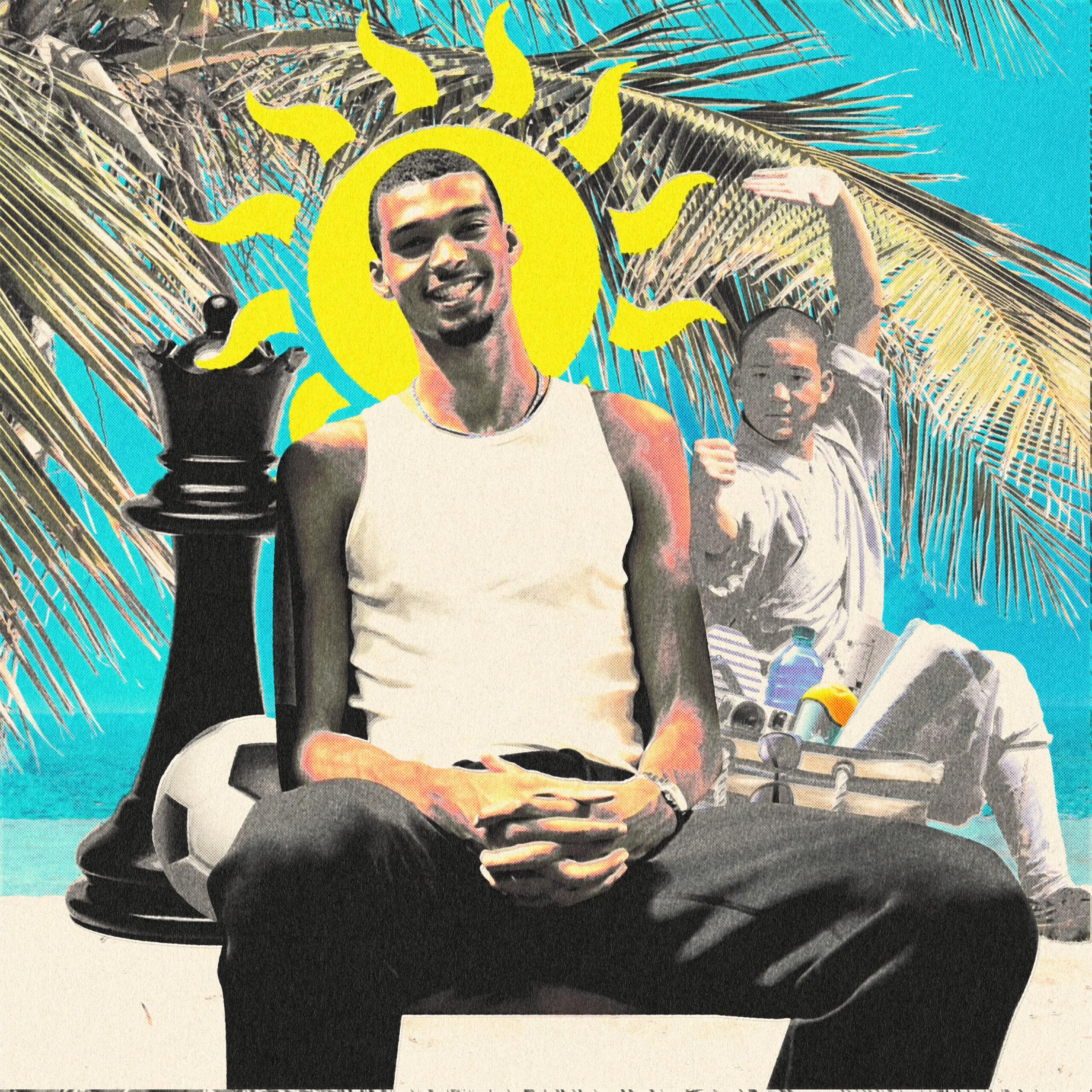
There are countless clips of the Shaolin kung fu master Shi Dejian practicing his taolu on the verge of oblivion. Standing on a gable roof or a ledge barely wider than a narrow stance, the master flows through intricate, wavelike movements at the cliff’s edge of Mount Song in the Henan province of China, without any safeguards against what would be a plunge to certain death. He does so, often, with a smile. “Kung fu is not only training the body,” he once said. “It is also about controlling fear.”
One must imagine Victor Wembanyama would be drawn to such an act—the audacity to perform it could be derived only from a profound measure of discipline. Wembanyama, of course, made headlines earlier this summer for entering the chambers: a 10-day retreat training body and mind at the Shaolin Monastery, where he earned an entry-level rank in the Shaolin kung fu system (which, given his outsize proportions and the limited time he spent at the temple, is arguably one of the most impressive physical feats he’s ever accomplished).
“We were initiated there to the life of a warrior monk, which combines Buddhism and intensive kung fu practice,” Wembanyama told the French newspaper L’Équipe. “It was very hard. We discovered movements that we had never done in our lives. It was more than 1,000 kicks to do per day, jumps, balance exercises, stretching. We used muscles that we rarely used and which were quickly overloaded. I had some of the biggest aches and pains of my life.”
Kung fu is not only training the body. It is also about controlling fear. Wembanyama looked out from the edge of his own personal oblivion back in February, when he was diagnosed with deep vein thrombosis in his right shoulder, ending what had been an astonishing sophomore season. “I was afraid of not being able to play basketball anymore,” Wembanyama admitted earlier this month. “I think that we all have thoughts sometimes, irrational thoughts about the things we care about most. But this type of thinking also changes you as a person, for the better.”
Having caught a brief glimpse of his basketball mortality, Wembanyama has done what any other 21-year-old with means would do: He’s gone globe-trotting. Wemby has boasted an enviable itinerary since his season-ending diagnosis: playing soccer with kids in Costa Rica, practically reenacting Game of Death at the Shaolin Monastery, drilling a free kick and hitting the SIUUU (and subsequently enjoying himself at a nightclub) in Tokyo, and hosting the inaugural “Hoop Gambit” tournament in his hometown of Le Chesnay just west of Paris, which housed a chess competition and one-on-one and three-on-three basketball games on courts that he helped create and design for the community. All this amid one of the most pivotal summers in Spurs franchise history—one that has forced San Antonio to interrogate its position in the league hierarchy, knowing just how good Wemby is and can be. There’s a sense that both parties have found clarity in the process.
Earlier this month, both Wemby and the Spurs confirmed that he’s been medically cleared to play basketball again after five months of recovery. San Antonio will be the biggest wild card of the 2025-26 NBA season, with a ceiling that will be defined by what Wembanyama’s next leap looks like. Perhaps we’ll look back and immortalize this strange period as the Summer of Wemby, in which basketball’s final frontiersman leveled up by doing everything except playing basketball.
The locales were a bit more far-flung this summer, but Wemby has always taken an interdisciplinary approach to offseason training. A Men’s Health story from March detailed the unconventional speed drills Wemby put himself through in the summer after his rookie year, as he found ways to simultaneously prepare for an intense physical and mental load. Wembanyama’s high-intensity interval training would start with cardio on an exercise bike, VersaClimber, or underwater treadmill, which would immediately be followed by a minute-long round of lightning chess with whatever Spurs employee was around. Then back to cardio, then back to chess. A 30-minute workout would include six rounds of play. (Longtime Toronto Raptors TV analyst Jack Armstrong has, over the years, taken to describing the game of basketball as “turbo chess.” In Wemby, he’s found his avatar.)
“If you can transition from, say, playing chess to training your body at a high level on a cardio burst, that makes basketball so much easier, and it makes the game so much slower to you,” trainer Melvin Sanders told Men’s Health. Consider it an analog version of the virtual reality simulations that 2024 NFL Offensive Rookie of the Year Jayden Daniels credits for his high-level processing on the field.
“There’s definitely growing research that says variability of practice, getting different exposure to different types of play, is important,” Rob Gray, a sports scientist for the Chicago Cubs and Arizona State University professor of human systems engineering, told me in 2021. “Those kinds of conditions make you more adaptable and a good problem solver instead of just executing one play all the time.
“I think that’s part of what makes great players look like they’re a couple seconds ahead of everybody. They’re picking up something a little bit before it actually evolves,” Gray continued. “They’re seeing the movement, picking up some cue or pattern. The same way a great chess master can see what you’re trying to execute well before it’s unfolded. There’s so little time in these sports for you to wait for things to be obvious. If you wait, it’s too late.”
Wembanyama hasn’t played actual basketball in nearly half a year, but he’s trained his body in novel ways, exploring his range of motion and physical endurance, gathering more data on the constraints of his titanic frame. He’s also had plenty of time to imagine himself back on the court, to envision the kind of player he hopes to become. He is already close to self-actualization on defense, or at least is nearing the outer limits of how defensive impact can be quantified. Only Manute Bol and Wembanyama have recorded multiple seasons with at least 1,500 minutes played and at least a 10 percent block rate. Bol had three such seasons across a 10-year career; Wembanyama has two in his first two seasons. Wemby warps an augmented reality on defense by virtue of his fluidity, timing, spatial awareness, and physical dimensions. That much has been apparent from the second he stepped foot on an NBA court.
But when I think about what’s left to explore and refine on offense, my mind drifts to a late-January game against the Clippers. (The Spurs lost, but that’s beside the point.) His first basket came off what would typically be considered a terrible lob pass from Devin Vassell that only Wembanyama could reach—and even then, only barely, requiring full extension. Thus, it was a perfect pass; just as Wemby is grasping his affordances on the court, so, too, are his teammates in their supporting roles.
Mostly, though, I think about the six 3s Wembanyama attempted in that game, half of them from at least 28 feet out. At this stage of his journey, Wemby is still flirting with the unprecedented promise of his game; he’s still toying with conventional wisdoms. Defenses aren’t meant to expect a 7-foot-3 center to bring the ball up the court after a rebound, at full speed, before pulling up for a deep 3; they shouldn’t need to anticipate a player that size being able to seamlessly transfer his energy with the side of his foot à la Shai Gilgeous-Alexander and then drill a stepback triple. Wemby hit three 3s that game, each one in transition: a pull-up, a stepback, a trailer. Next season, playing alongside three penetrative ball handlers in De’Aaron Fox, Stephon Castle, and Dylan Harper—each with their own signature of speed, strength, and guile, respectively—Wembanyama ought to have plentiful opportunities as a trailer. That’s terrifying.
Last season, Wembanyama hit 42.2 percent of his 3-pointers in transition, according to Synergy Sports—his third-most common play type that resulted in a 3, behind spot-ups and popping in a pick-and-roll. It’s a shot that will always be available to him, and it will more often than not be wide open. What can be done at the point of attack against a center with an 8-foot wingspan comfortably pulling up from 30 feet out? How do you confront that kind of anomaly when decades of positional orthodoxy are embedded in one’s muscle memory? “By forcing defenses to acknowledge the potency of every inch of the floor, you take control of your opponent,” I wrote nearly a decade ago in the inaugural story published on The Ringer, examining the influence of Steph Curry through the lens of the Ball family. “The NBA had to learn how to prevent shots that, before, never had to be guarded in the first place.” It’s happening again.
Wemby consistently takes the long view, and it’s emboldened the Spurs organization to follow suit. NBA history proves that there are only so many chances a franchise gets to build around a defining talent—and even the best-laid plans often go awry. The noise of pairing Wembanyama with the likes of Giannis Antetokounmpo or Kevin Durant faded as quickly as it emerged. The league and its followers have become conditioned to think in terms of closing windows and ticking clocks, but there is an almost unnerving sense of calm and foresight from Wembanyama. He’s in no hurry; he’s got his own sense of time.
Even with full basketball clearance, he has opted against participating in next month’s FIBA EuroBasket 2025 in favor of working his way back into basketball shape gradually. “I have to continue specific work on my shoulder and especially get back into everything related to my basketball habits,” Wembanyama said. “It’s been five months since I’ve played a five-on-five match. If I had to have a game tomorrow, it would be risky. There are plenty of reflexes to find, both conscious and linked to muscle memory.”
Though he’s still just 21 years old, Wembanyama has earned a measure of goodwill rarely bestowed; there is faith in his unorthodoxy, trust in the holistic sensibility of his training. This has been a moment in time to understand and appreciate elite performance in sports as a practice divorced from monomaniacal focus. Scottie Scheffler’s historic heater on the green feels like the by-product of a sort of existential liberation; Wembanyama’s generational potential is augmented—perhaps even validated—by his insatiable curiosity. If basketball is a complex expression of both the self and the union of many, then it stands to benefit from external stimuli. Wemby’s retreat to the Shaolin Monastery could simply have been a once-in-a-lifetime summer adventure, but given what we know about how Wembanyama situates himself in the universe, it’s likely there was a deeper intention at play.
In an episode of the 2008 BBC documentary series Extreme Pilgrim, we see master Shi Dejian demonstrating his patented death-defying wushu along the cliffside roof, but not before mopping his altar space with the same flow and economy of motion that he uses in his kung fu. The movements are the same; the practice is the same. Kung fu is fighting; it’s also mopping, pouring tea, and executing calligraphy. It’s the kind of embodied practice that might serve as an organizing principle in Wemby’s grand unified theory—one where chess, fantasy novels, martial arts, and basketball all convey tonal variations of the same base language.
One imagines Wembanyama feeling a sense of kinship with the Shaolin master. Shi Dejian, too, was once a 19-year-old prodigy who left home in search of the ultimate refinement; he found it in those Songshan Mountains over the past four-plus decades, just like Wemby is finding his own path along the San Antonio River.

